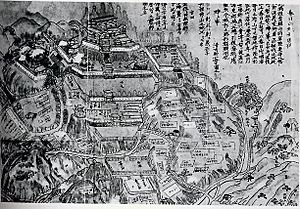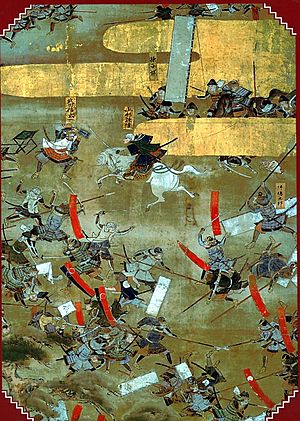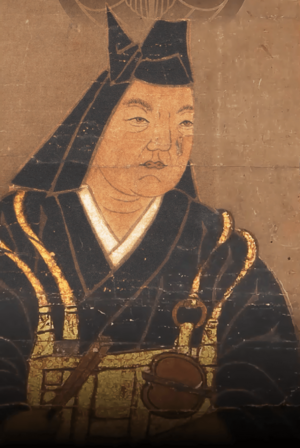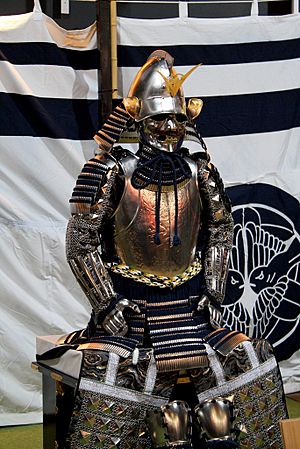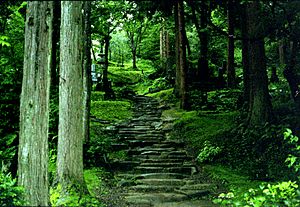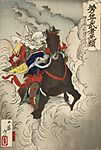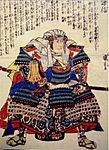Uesugi Kenshin facts for kids
Quick facts for kids
Uesugi Kenshin
|
|
|---|---|
|
上杉 謙信
|
|
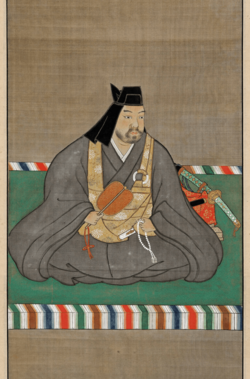
Uesugi Kenshin portrait from Uesugi Shrine
|
|
| Head of Uesugi clan | |
| In office 1561–1578 |
|
| Preceded by | Uesugi Norimasa |
| Succeeded by | Uesugi Kagekatsu |
| Head of Nagao clan | |
| In office 1548–1578 |
|
| Preceded by | Nagao Harukage |
| Succeeded by | Uesugi Kagekatsu |
| Personal details | |
| Born |
Nagao Kagetora
February 18, 1530 Echigo Province, Japan |
| Died | April 19, 1578 (aged 48) Echigo Province, Japan |
| Parents |
|
| Relatives | Uesugi Norimasa (adopted father) Nagao Harukage (brother) Aya-Gozen (sister) Nagao Masakage (brother-in-law) Uesugi Kagekatsu (adopted son) Uesugi Kagetora (adopted son) |
| Nicknames | "Dragon of Echigo" "God of War" |
| Military service | |
| Allegiance | |
| Rank | Lord (Daimyō) |
| Unit | |
| Commands | Kasugayama Castle |
| Battles/wars | Siege of Tochio (1544) Battles of Kawanakajima (1553, 1555, 1557, 1561, 1564) Siege of Odawara (1561) Siege of Karasawa (1563) Battle of Tonegawa (1571) Siege of Kanayama (1574) Siege of Nanao (1576-1577) Battle of Tedorigawa (1577) |
Nagao Kagetora (長尾 景虎, February 18, 1530 – April 19, 1578), later known as Uesugi Kenshin (上杉 謙信), was a powerful Japanese daimyō (a feudal lord). He was born into the Nagao clan and later adopted into the Uesugi clan. Kenshin ruled Echigo Province during Japan's Sengoku period, a time of great civil war.
He was known as the "Dragon of Echigo" because of his amazing skills in battle. Kenshin was also a very good leader who helped local businesses grow. Under his rule, people in Echigo had a better life.
Kenshin was famous for being honorable and a military genius. He had a long rivalry with another famous lord, Takeda Shingen. Kenshin also believed in Buddhist god of war, Bishamonten. Many people thought he was an avatar (a form) of Bishamonten and called him the "God of War".
Contents
Understanding Kenshin's Names
Uesugi Kenshin had several names throughout his life. His birth name was Nagao Kagetora (長尾景虎).
He changed his name to Uesugi Masatora (上杉政虎) when he became the head of the Uesugi clan. This allowed him to take on the important title of Kantō Kanrei, which was like a governor for a large region.
Later, he changed his name again to Uesugi Terutora (上杉輝虎). This was to honor the 13th shōgun (military ruler) of Japan, Ashikaga Yoshiteru.
Finally, he became known as Kenshin (上杉謙信) after he decided to become a Zen-Buddhist monk. He was especially devoted to the war god Bishamonten.
Kenshin was born in the Year of the Tiger in the Chinese zodiac. He always kept the word "tora" (虎, tiger) in his names. People respected him as "The Tiger of Echigo" for his smart decisions and great contributions.
He was also called "The Dragon of Echigo" because of a special flag he used in battle. His rival, Takeda Shingen, was known as "The Tiger of Kai". The Dragon and Tiger are rivals in some Chinese mythology stories. This shows how strong their rivalry was.
Before going to war, Kenshin would pray at the shrine of Bishamonten. He would have a special meal with his generals and perform rituals to bring good luck.
Kenshin's Early Life
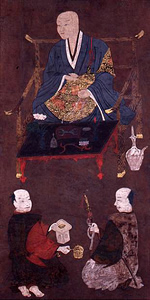
Kenshin was born as Kagetora, the third or fourth son of a famous warrior named Nagao Tamekage. His family, the Nagao clan, served the Uesugi clan. Kenshin's father was known for winning battles against his own lords.
However, in later years, Kenshin's father faced problems with the Ikkō-ikki group. In 1536, Kenshin's father was killed in battle.
After his father's death, Kenshin's older brother, Nagao Harukage, took control of the Nagao clan. Kenshin was sent away to Rinsen-ji temple. From age 7 to 14, he studied, practiced martial arts, and learned about Zen Buddhism.
Kenshin's Rise to Power
When Kenshin was 14, some of his late father's friends asked him to return. They wanted him to challenge his older brother's rule. Harukage was not a strong leader, and the province was falling apart.
At first, Kenshin didn't want to fight his own brother. But he was convinced it was necessary to save Echigo. At age 15, he helped defend Tochio Castle from rebels. He became known for his bravery.
In 1548, Kenshin took control of the Nagao clan from his brother, Harukage. Harukage stepped down and gave his titles to Kenshin. Five years later, Harukage died. At 19, Kenshin became the head of the Nagao clan and moved into Kasugayama Castle. He was still a retainer of the Uesugi clan at this time.
In 1551, Kenshin's lord, Uesugi Norimasa, needed a safe place to stay. Norimasa had been forced to flee his lands by the powerful Hōjō clan. Kenshin agreed to help Norimasa, but with conditions. Kenshin would become Norimasa's adopted heir. He would also change his name to Terutora and gain the title of Lord of Echigo. Most importantly, he would become the Kantō Kanrei, a very high position.
In 1552, the Uesugi clan began fighting the Hōjō clan. Kenshin worked to strengthen his control over Echigo. Soon, two lords from Shinano province, Ogasawara Nagatoki and Murakami Yoshikiyo, asked Kenshin for help. They needed him to stop the advances of the powerful lord Takeda Shingen. Kenshin agreed to help, and this led to many conflicts and alliances.
Kenshin was successful in battle partly because he improved trade and transportation. He also collected taxes better. This gave him more control over the economy. He also gave land to his warriors, which made them loyal to him.
Battles with Takeda Shingen
Kenshin's rivalry with Takeda Shingen became famous in Japanese history. They fought five times at a place called Kawanakajima between 1553 and 1564. Only the fourth battle was a large, all-out fight.
The Fourth Battle of Kawanakajima
In 1561, Kenshin and Shingen fought their biggest battle. Kenshin used a clever tactic. He had his tired soldiers in the front switch places with fresh soldiers in the back. This allowed his army to keep fighting strongly. This tactic almost led Kenshin to defeat Shingen.
There is a famous story from this battle. Kenshin rode directly to Shingen and attacked him with his sword. Shingen defended himself with his iron war fan. Kenshin could not finish the fight before Shingen's men drove him away. Shingen then counter-attacked, and Kenshin's army retreated.
Historians still debate who won this battle. Many consider it a draw. It was one of the bloodiest battles of the Sengoku period. Both sides lost many soldiers and important generals.
In 1563, Shingen allied with Hōjō Ujiyasu against Kenshin. They captured Matsuyama Castle. In 1571, Kenshin attacked one of Shingen's castles, and they faced each other again, but the battle ended without a clear winner.
There was a time when the Hōjō clan stopped sending salt to Shingen's province. When Kenshin heard about this, he sent salt to Shingen from his own lands. Kenshin said he did not fight with salt, but with the sword. This showed his respect for Shingen.
Kenshin's respect for Shingen was clear when Shingen died. Kenshin reportedly cried and said, "I have lost my good rival. We won't have a hero like that again!"
Conflicts with the Hōjō Clan
Even with his rivalry with Shingen, Kenshin was involved in other battles. In 1559, he traveled to Kyoto to visit the shōgun. This trip made him even more famous as a cultured leader.
In 1560, Kenshin was urged by Uesugi Norimasa to take back the Kantō region from the Hōjō clan. Kenshin agreed. He put southern Echigo under the control of a council to prepare for war.
Siege of Odawara Castle
Kenshin led a campaign against Hōjō Ujiyasu from 1560 to 1561. He captured several castles from the Hōjō, including Numata Castle. He then laid siege to Odawara Castle. Kenshin broke through the defenses and burned the surrounding town. However, he could not capture the castle itself because of threats from Shingen.
In 1563, Kenshin helped his ally Ōta Sukemasa, who was being attacked by both Hōjō Ujiyasu and Takeda Shingen. Later, in 1569, when Shingen besieged Odawara Castle, Ujiyasu even asked Kenshin for help.
In 1574, Kenshin attacked Kanayama Castle, which was held by the Yura clan, who had switched their loyalty to the Hōjō. However, Kanayama Castle was able to defend itself.
Uesugi's Growing Power
Kenshin was also interested in Etchū Province to the west. He spent almost half his life dealing with the politics there. The province had two fighting clans, the Jinbo clan and the Shiina clan. Kenshin first tried to make peace between them. Later, he sided with the Shiina and took over the Jinbo clan. Years later, Kenshin turned against the Shiina clan, capturing their main castle in 1575.
By 1564, Kenshin controlled both Etchū Province and Kōzuke Province. By the 1570s, he governed Echigo Province, nearby provinces, and the entire Hokuriku region coastline. He even defeated Oda Nobunaga's forces in Echizen Province.
Conflict with Oda Nobunaga
Starting in 1576, Kenshin began to see Oda Nobunaga as a major threat. Nobunaga was becoming the most powerful lord in Japan. Kenshin ended his alliance with Nobunaga. He formed a new alliance with other lords who opposed Nobunaga.
With both Takeda Shingen and Hōjō Ujiyasu dead, Kenshin could expand his territory. When a lord in Noto Province died, causing confusion, Kenshin quickly took advantage. He captured land and successfully besieged Nanao Castle. This put him in a position to threaten Nobunaga.
In response, Nobunaga gathered his forces and his best generals, Shibata Katsuie and Maeda Toshiie. They met Kenshin at the Battle of Tedorigawa in 1577.
Battle of Tedorigawa
Kenshin had an army of 30,000 soldiers. Nobunaga's forces were larger, with 50,000 troops. Despite being outnumbered, Kenshin won a strong victory.
Kenshin expected Nobunaga to try a night attack. He pretended to send a small unit to attack Nobunaga's main force from behind. Nobunaga fell for the trick. Nobunaga's army attacked at night, expecting a weak opponent. Instead, Kenshin's full army was waiting. Nobunaga's forces lost many men and had to retreat. Kenshin secured Noto Province from the Oda clan.
Kenshin's Death
In October 1577, Uesugi Kenshin planned a large army to continue his attacks into Nobunaga's lands. In 1578, he formed an alliance with Takeda Katsuyori against Nobunaga. However, bad weather delayed his plans. He died in the spring of 1578.
The exact cause of Kenshin's death has been debated. Early records mention his health getting worse and him complaining of chest pain. Some historical accounts say he had a stomach ache that lasted for several days before he died. There is also a theory that he was assassinated by a ninja hiding in a latrine. However, Kenshin's own writings suggest he expected his death, making assassination less likely.
Kenshin did not have any biological children. He adopted two boys during his life: his nephew, Uesugi Kagekatsu, and Uesugi Kagetora, who was the son of Hōjō Ujiyasu. It is thought that Kenshin intended to divide his lands between them.
After Kenshin's death, a struggle for power began between his adopted sons. This led to a long period of fighting in Echigo, known as the "Otate Disturbance." Kagekatsu eventually won and became the new head of the Uesugi clan. Kagetora fled and died in 1579.
This internal struggle weakened the Uesugi clan. The Oda clan took advantage of this to expand their territory. The destruction of the Takeda clan, who were allies of the Uesugi, also put the Uesugi clan in danger. However, Oda Nobunaga's own death soon after changed the balance of power in Japan once more.
Kenshin Festivals
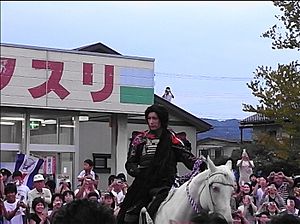
The Kenshin Festival (謙信公祭 (Kenshin Kousai)) is held every August in Jōetsu, Niigata. It has been celebrated since 1926. The festival includes a procession from Kasugayama Castle and a reenactment of the fourth Kawanakajima battle. Hundreds of people dress as soldiers for the event.
Japanese singer-songwriter Gackt has played Kenshin many times since 2007. His participation helped the festival reach a record attendance of 243,000 people in 2015.
Another event, the Echigo Kenshin Sake Festival, takes place every October. It attracts about 100,000 visitors.
The Theory of a Female Uesugi Kenshin
In the mid-20th century, a Japanese novelist named Tomeo Yagiri suggested that Uesugi Kenshin might have been a woman. He found an old report from the 16th century in Spain that referred to Uesugi as the "aunt" of Uesugi Kagekatsu. This led Yagiri to believe that in the West, Kenshin was thought to be a woman.
Other points supporting this idea include historical records that Kenshin had severe stomach pains around the 10th of each month. Some accounts also describe Kenshin's appearance as feminine. Portraits from the Sengoku period show a more delicate look, while later portraits tried to make Kenshin look more masculine.
Kenshin was allowed to enter the women's quarters in the Kyoto Imperial Palace, which was very unusual. Kenshin also never had any biological children, a wife, or a concubine.
In popular culture, Kenshin is sometimes shown as female or having an undefined gender. People who disagree with this theory say that women could not lead samurai clans. However, supporters point out that there were some female samurai leaders in the 16th century, such as Tachibana Ginchiyo and Ii Naotora.
Gallery
-
Kenshin's mythical riding into battle by Tsukioka Yoshitoshi (1883)
-
Kenshin depicted by Utagawa Kuniyoshi (1843–1844)
-
Kenshin depicted by Utagawa Kuniyoshi (1845)
Honors
- Junior Second Rank (September 9, 1908; given after his death)
See also
 In Spanish: Uesugi Kenshin para niños
In Spanish: Uesugi Kenshin para niños
- Naoe Kanetsugu
- Aya-Gozen


